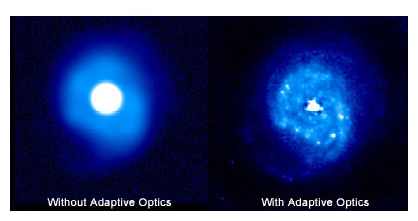Adaptive Optics
Adaptive optics is an emerging field with applications in areas as diverse as astronomy, opthalmology, 3D imaging, retinal imaging (see Figure 1), laser material processing and military imaging. Light is distorted by the medium through which it travels, adaptive optics attempts to compensate for that distortion to produce more clear and detailed images.


where I is the intensity measurements and φ is the wave-front phase.
The numerical solution of diffusion type equations has been studied extensively, yet there is no recognised technique for solving the irradiance transport equation.
Part of the reason is due to the experimental set-up. There is also a more subtle, but important, issue; and that is the effect of noise in the intensity measurements.
Very accurate, robust and fast calculations of the wave-fronts are required to control these systems and to return high resolution images in real time. The only way to achieve this goal is to use techniques that are at the forefront of both the mathematical and computer sciences.
These tools include the choice of appropriate basis functions that can be calculated quickly and can handle the noise present in experimental data. We also plan to address issues where algorithms and architecture interact, namely the efficient use of memory systems for obtaining high performance.
File translated from TEX by TTH, version 3.67.
On 23 Oct 2005, 20:12.
Adaptive optics is an emerging field with applications in areas as diverse as astronomy, opthalmology, 3D imaging, retinal imaging (see Figure 1), laser material processing and military imaging. Light is distorted by the medium through which it travels, adaptive optics attempts to compensate for that distortion to produce more clear and detailed images.



|
File translated from TEX by TTH, version 3.67.
On 23 Oct 2005, 20:12.